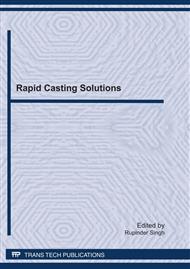p.1
p.9
p.15
p.21
p.31
p.43
p.61
p.77
Experimental Investigations for Rapid Moulding Solution of Plastics Using Polyjet Printing
Abstract:
Rapid prototyping (RP) has been in evidence for the past twenty years and is being widely used in diverse areas, from the building of aesthetic and functional prototypes to the production of tools and moulds for technological prototypes. The purpose of the present study is to experimentally investigate the rapid moulding (RM) solutions for plastic components using polyjet printing (PP) technique. Starting from the identification of component/benchmark, prototypes with three different type of plastic material were produced, at different orientation and support material. Measurements on the coordinate measuring machine helped in calculating the dimensional tolerances of the plastic components produced. Some important mechanical properties were also compared to verify the suitability of the components. The study highlighted the best orientation, support material quantity and type of plastic material for the selected component from dimensional accuracy and economic point of view as RM solution for plastic components. This process ensures rapid production of pre-series technological prototypes and proof of concept at less production cost and time.
Info:
Periodical:
Pages:
15-20
Citation:
Online since:
October 2011
Authors:
Price:
Сopyright:
© 2012 Trans Tech Publications Ltd. All Rights Reserved
Share:
Citation:


